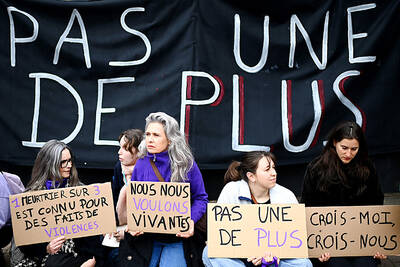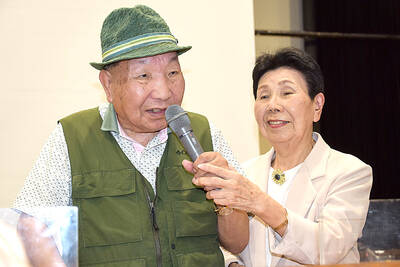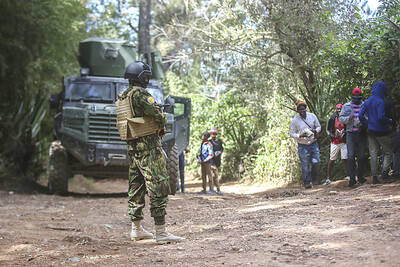The death toll from the US military’s largest non-nuclear bomb nearly tripled yesterday, with Afghan officials saying that at least 90 Islamic State fighters were killed, as US-led forces conducted clean-up operations over the rugged terrain.
The GBU-43/B Massive Ordnance Air Blast bomb (MOAB) — dubbed the “Mother Of All Bombs” — was unleashed in combat for the first time, hitting Islamic State positions in eastern Nangarhar province on Thursday.
The bombing triggered shock waves in Afghanistan, with some condemning the use of Afghanistan as what they called a testing ground for the weapon, and against a militant group that is not considered a threat as big as the resurgent Taliban.
“At least 92 DAESH fighters were killed in the bombing,” Achin district governor Esmail Shinwari told reporters, using an Arabic-language acronym for the Islamic State.
Shinwari said that there were “no military and civilian casualties at all.”
Nangarhar provincial spokesman Attaullah Khogyani gave a toll of 90, although The Associated Press reported Khogyani giving a toll of 94.
Afghan officials had earlier said the bombing had killed 36 Islamic State fighters.
The bomb smashed the militant group’s remote mountain hideouts, a tunnel-and-cave complex that had been mined against conventional ground attacks, engulfing the remote area in a huge mushroom cloud and towering flames.
Security experts say that the Islamic State had built their redoubts close to civilian homes, but the government said thousands of local families had already fled the area in recent months of fighting.
The massive bomb was dropped after fighting intensified over the past week and US-backed ground forces struggled to advance on the area.
A US special forces soldier was killed on Saturday last week in Nangarhar while conducting anti-Islamic State operations.
Afghan President Ashraf Ghani threw his support behind the bombardment, saying it was “designed to support the efforts of the Afghan National Security Forces and US forces conducting clearance operations in the region.”
However, some analysts called the action “disproportionate.”
“The [US President Donald] Trump administration made a lot of noise with this bomb, but the general state of play on the ground remains the same: The Taliban continues to wage a formidable and ferocious insurgency. ISIS, by comparison, is a sideshow,” Michael Kugelman of the Woodrow Wilson Center in Washington told AFP, using another acronym for the Islamic State.
“Still, from a strategic standpoint, there is an unsettling takeaway here: The US pulled off a huge shock-and-awe mission against an enemy that isn’t even the top threat to the US in Afghanistan. The Taliban continues to sit pretty,” Kugelman said.
The Islamic State, notorious for its reign of terror in Syria and Iraq, has made inroads into Afghanistan in recent years, attracting disaffected members of the Pakistani and Afghan Taliban as well as Uzbek militants.
However, the group has been steadily losing ground in the face of heavy pressure both from US airstrikes and a ground offensive led by Afghan forces.

A French-Algerian man went on trial in France on Monday for burning to death his wife in 2021, a case that shocked the public and sparked heavy criticism of police for failing to take adequate measures to protect her. Mounir Boutaa, now 48, stalked his Algerian-born wife Chahinez Daoud following their separation, and even bought a van he parked outside her house near Bordeaux in southwestern France, which he used to watch her without being detected. On May 4, 2021, he attacked her in the street, shot her in both legs, poured gasoline on her and set her on fire. A neighbor hearing

DEATH CONSTANTLY LOOMING: Decades of detention took a major toll on Iwao Hakamada’s mental health, his lawyers describing him as ‘living in a world of fantasy’ A Japanese man wrongly convicted of murder who was the world’s longest-serving death row inmate has been awarded US$1.44 million in compensation, an official said yesterday. The payout represents ¥12,500 (US$83) for each day of the more than four decades that Iwao Hakamada spent in detention, most of it on death row when each day could have been his last. It is a record for compensation of this kind, Japanese media said. The former boxer, now 89, was exonerated last year of a 1966 quadruple murder after a tireless campaign by his sister and others. The case sparked scrutiny of the justice system in

DITCH TACTICS: Kenyan officers were on their way to rescue Haitian police stuck in a ditch suspected to have been deliberately dug by Haitian gang members A Kenyan policeman deployed in Haiti has gone missing after violent gangs attacked a group of officers on a rescue mission, a UN-backed multinational security mission said in a statement yesterday. The Kenyan officers on Tuesday were on their way to rescue Haitian police stuck in a ditch “suspected to have been deliberately dug by gangs,” the statement said, adding that “specialized teams have been deployed” to search for the missing officer. Local media outlets in Haiti reported that the officer had been killed and videos of a lifeless man clothed in Kenyan uniform were shared on social media. Gang violence has left

US Vice President J.D. Vance on Friday accused Denmark of not having done enough to protect Greenland, when he visited the strategically placed and resource-rich Danish territory coveted by US President Donald Trump. Vance made his comment during a trip to the Pituffik Space Base in northwestern Greenland, a visit viewed by Copenhagen and Nuuk as a provocation. “Our message to Denmark is very simple: You have not done a good job by the people of Greenland,” Vance told a news conference. “You have under-invested in the people of Greenland, and you have under-invested in the security architecture of this